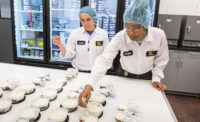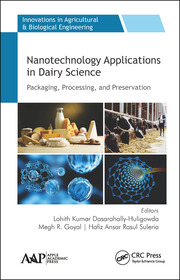
Executive Editor
Meet the Participants
Dave Andronico, regional sales manager, Reiser, Canton, Mass.
Suzanne Betker, business intelligence manager, Curwood Inc., Oshkosh, Wis.
Scott Bossong, director of dairy marketing, Sealed Air’s Cryovac food packaging division, Elmwood Park, N.J.
Bill Harris, president, Spiralkote Flexible Packaging, Orlando, Fla.
Dan Mack, product manager, Multivac Inc., Kansas City, Mo.
Elizabeth Sheaffer, marketing manager, Zip-Pak, Manteno, Ill.
When it comes to the dairy industry, controlling costs, decreasing environmental footprint and increasing shelf life are incremental parts of creating a new product. However, the product is no good when it comes in a difficult-to-open package.
Executive Editor Marina Mayer interviewed a lineup of suppliers to discuss what processors look for in flexible packaging, what challenges they face and how suppliers are solving these challenges with an array of new packaging options.
Dairy Foods: What are dairy processors demanding from flexible packaging?
Mack: Modern dairy processors are seeking to boost competitiveness and reduce costs by means of labor and process efficiencies, as well as the overall reduction in use of packaging materials. Use of more advanced, thinner-gauge materials can often address that requirement while also improving functionality and consumer appeal. Having equipment with exacting sanitary design that is easily cleanable is mandatory. Packaging processes that lend themselves to more sanitary routines are also highly desirable.
Bossong: Dairy processors are demanding a higher level of consumer convenience and materials efficiency benefits from flexible packaging solutions. When it comes to consumer convenience, they are specifically looking for packaging that allows for portion control and smart storage solutions. Portion control packaging gives consumers access to the correct amount of product, minimizing food waste in many instances while smart storage solutions adds to the consumer’s ease of use throughout the life of the product and can maximize product quality and cleanliness.
Andronico: Dairy processors are asking for high barrier materials, durable, light in weight and high in clarity. They are looking for reduced packaging material costs. The features that they are most interested in are reclosability and resealability. They also desire environmentally friendly/green materials without sacrificing the performance that they have become accustomed to. Single portion as well as club-store sizes are required.
Sheaffer: Dairy processors are constantly looking at ways to control costs and decrease their environmental footprint. Flexible packaging offers benefits in both areas. A research study conducted by Franklin Associates [Prairie Village, Kan.] and commissioned by Zip-Pak concluded that resealable flexible packaging is a more sustainable option when compared to rigid containers due to its superior product-to-product [package] ratio, lower energy footprint and lower greenhouse gas emissions throughout the package’s life-cycle. Due to the superior product-to-package ratio, dairy producers can simultaneously decrease their spending on packaging materials by switching from rigid containers to flexible pouches.
Betker: Packages that deliver easy opening features and the elimination of tools, like a knife, to open a package are important in reducing contamination opportunities. Dairy processors are also expecting new and innovative portion control formats for the growing dairy snack market, primarily focusing on natural cheese items. There is the continued demand for packaging solutions that reduce leakers and allow higher machine speeds to increase throughput and efficiencies in the dairy processors facility. An example is ultrasonic sealing technology that is re-emerging with better control versus prior attempts. Films specifically engineered for ultrasonic applications have been developed to meet the requirements needed on ultrasonic sealing packaging equipment.

Mack: Multivac introduced FormShrink packaging. FormShrink is an in-line method of creating product-specific contoured shrink packaging using a specially engineered thermoforming machine. Shrinkable roll-fed film is used to create the bottom portion of the package. Product is placed into this “pocket” before the top web of film is positioned, hermetically sealed, shape-cut and ultimately passed through a steam shrink tunnel to activate the film’s shrink properties. A perfect shrink package is thus created, which is ideal for virtually any shape of solid cheese product. The process reduces labor expense because top-loading of a thermoform packaging machine is easier and less time-consuming than manually placing product in traditional shrink bags.
Andronico: Repak horizontal form/fill/seal packaging machines feature sophisticated transport systems to handle large cheese blocks as well as reclosable systems for consumer packages. A variety of cutting features are available to create multiple packages that can be sold as one sales unit and then separated by the consumer into individual portions for consumption. The Supervac line of vacuum packaging equipment is capable of handling pre-formed laminate and shrink bags for products as large as 40-pound blocks down to individual consumer packages. Conveying and transport systems are available to streamline packaging lines and increase throughput.
Sheaffer: Our Packaging Realization Team is a group of Zip-Pak experts assembled to consult with consumer package goods (CPG) companies and retailers on how to implement cost-effective, efficient and sustainable resealable pouches. Each CPG we work with is assigned a unique team made up of people from various disciplines, including marketing, product development and machinery. This consulting service acts as a packaging think-tank, helping companies implement new packaging and solve challenges.
Bossong: In June, we launched the Multi-Seal FoldLOK package, which is currently designed for shredded cheese applications and utilizes robust adhesive technology, allowing consumers of all ages to easily and reliably open and reclose the package multiple times without needing to completely remove the top or use zippers. This results in a positive customer experience and reduction in packaging materials over current reclosable formats. The Cryovac Portion-Pull Bag features easy open access with a straight, consistent tear requiring no use of scissors or knives. This product also allows better storage for less discoloration producing maximum shelf life.
Betker: With convenience packaging playing an important role in today’s market, Curwood has the capability to offer multiple opening features to cover all package formats. Examples include IntegraScore, IntegraCut, IntegraDirect, EZ Peel, EZ Peel Reseal and IntegraPeel.
Dairy Foods: How has the new food safety law affected packaging for dairy processors’ products?
Mack: One area where we see great opportunities for helping dairy processors with legal and regulatory requirements is in track-and-trace technology. Multivac’s systems group can provide this to processors on most packaging lines.
Bossong: The new food safety laws have underscored the need for processors to ensure cleanliness, and proper performance carries across all operations, including packaging. Processors are expected to guarantee shelf life studies are up-to-date and that packaging materials contain proper barrier properties. Additionally, processing plants are very conscience of keeping packaging environments clean and sanitary, including mandating that proper clean clothing must be worn in all areas where dairy products are packaged.

Mack: Consumer convenience and brand differentiation continue to be key issues for most dairy processors. Multivac has been able to help meet those challenges with technologies, including “peel/reseal” packages, tear tab opening features and other reclosable solutions such as our semi-rigid serve box package.
Andronico: Minimizing packaging costs is a major challenge. Repak’s rapid air forming system allows the use of thinner, less expensive films while maintaining thickness in package corners, which results in up to 20% cost savings in packaging materials. Plus, Repak machines are constructed with two 4-point lifting stations that can generate up to five metric tons of closing pressure for reliable sealing and more uniform forming. Reliable seals mean less rework, fewer returns and ultimately, lower costs and higher profits. Reducing labor is another objective. Developing complete systems such as forming, auto-loading and packaging is also a focus at Reiser.
Harris: One challenging area is providing a sustainable material that offers the same shelf life as current materials used in the market. The Clondalkin companies are working on new technology that will try and improve shelf life along with improving sustainability at the same time.
Sheaffer: One of the biggest challenges dairy processors face is the inability to invest in capital equipment, including new packaging lines. Our technologies are capable of applying both Zip-Pak Slider and Zip-Pak Press-to-Close solutions and are ideal for a variety of cheese applications.
Bossong: Automation can lead to increased efficiencies for dairy processors by reducing labor and handling costs. Sealed Air’s Cryovac brand offers multiple automated solutions, including the recently BLX-F2 bag loader for cheeses ranging from 8 ounces to 12 pounds. Our customers can automate larger bag loading processes with the CL20 auto loading system for packaging 40-pound blocks of cheese. We also assist dairy processors in integrating their automated processes with our Packformance software, which allows processors to monitor the performance and efficiency of their entire packaging line.
Betker: Another challenge facing customers is the required commercialization time from concept to filling distribution with a commercial product. Curwood recognizes this and has created the Bemis Innovation Center in Neenah, Wis., where the focus is to create a centralized location for innovation as well as a customer destination. With the efforts of the Bemis Innovation Center and Bemis Graphics, concepts can be created on site and graphics can be applied quickly.
Food safety and contamination is another challenge - eliminating knives in foodservice and operations are critical. Curwood has focused on developing film structures with better barrier and higher abuse resistance materials to withstand the distribution demands and extend shelf life to ensure the food is safe and fresh. Opening features can be incorporated into the package to eliminate knives and reduce the possibility of contamination.
Dairy Foods: What’s next on the horizon for flexible packaging in the dairy industry?
Mack: We anticipate that energy efficiency, waste reduction, consumer convenience and brand differentiation will continue to be among the key drivers of dairy packaging going forward.
Harris: Packaging is becoming a large focus of selling a “brand” to increase its market share. The industry is demanding higher quality graphics with multiple changes such as promotions to increase “brand awareness.” Spiralkote Flexible Packaging is prepared with its nine-station printing presses, which provide the higher multi-color graphics that the market demands for the future.
Sheaffer: I think the future is in transparency. Not making packages see-through, but providing consumers with everything they need to know about the quality and the freshness of their food. For instance, we’ve considered ways to add an indicator label on the flange of our zippers. This advanced feature would provide the elapsed time since opening to consumers in an easy-to-read format, and since spoilage is a major consideration for dairy products, we see this and similar technologies taking hold in the years to come.
Bossong: The future in flexible packaging for the dairy industry is centered on convenience and efficiency. The main focus to ensure sustainability is in the form of downsizing packages and showing the net impact in sustainable savings throughout the product lifecycle, including package size, corrugated savings, pallet reduction and shipping savings.
Betker: There continues to be an interest in new packaging formats. Most dairy products, especially cheese, have been in the same format for decades and we are seeing an interest in alternative formats for superior shelf differentiation, cost reduction and efficient in-store stocking potential.
Extras
Curwood Inc www.curwood.com
Multivac Inc www.multivac.com
Reiser www.reiser.com
Sealed Air Cryovac www.sealedair.com
Spiralkote Flexible Packaging www.spiralkote.com
Zip-Pak www.zippak.com




